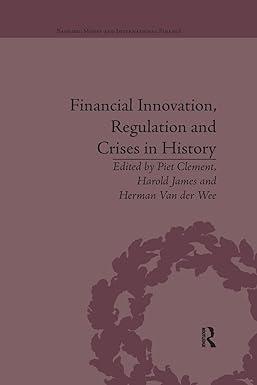Question
Consider the following information: Total invested capital = $10.5 million Debt-to-equity ratio = 0.6 Cost of equity = 8% Before-tax cost of debt = 5%
Consider the following information:
- Total invested capital = $10.5 million
- Debt-to-equity ratio = 0.6
- Cost of equity = 8%
- Before-tax cost of debt = 5%
- Tax rate = 40%
- EBIT for the Year 2011 = $1.3 million
Given that research and development expenditure amounting to $270,000 have been deducted to arrive at EBIT, the company's residual income and economic value added are closest to:
| Residual Income | Economic Value Added | |
| A | $298,875 | $298,875 |
| B | $136,875 | $298,875 |
| C | $136,875 | $926,875 |
Select one:
a.
Row A
b.
Row B
c.
Row C
Question 2
Question text
Consider the following information:
- Market price of stock on December 31, 2010 = $47
- Book value per share on December 31, 2010 = $21
- Consensus annual EPS forecasts:
- 2011 = $2.18
- 2012 = $2.75
- The company's dividend payout ratio is expected to remain constant at 40%.
Given a cost of equity of 11%, the company's residual income per share for 2011 and 2012 is closest to:
| 2011 ($) | 2012 ($) | |
| A | -0.27 | -0.11 |
| B | -0.13 | 0.30 |
| C | -3.13 | -2.75 |
Select one:
a.
Row A
b.
Row B
c.
Row C
Question 3
Question text
Michelle wants to value the stock of Gamma Corporation and gathers the following information:
- Current market price per share = $70
- Current book value per share = $28
- Perpetual ROE = 20%
- Perpetual growth rate = 5%
- Required rate of return on equity = 11%
The stock is most likely:
Select one:
a.
Undervalued.
b.
Fairly valued.
c.
Overvalued.
Use the following information to answer questions 4- 8: Diana wants to evaluate the stock of Eagle Inc, which is currently trading at $14.50 per share. She gathers the following information: Current book value per share = $9.50 ROE = 18% Expected EPS for Year 1-3 = ROE times beginning book value per share Dividend payout ratio = 40% Required rate of return on equity = 10% Question: The company's residual income per share at the end of Year 3 is closest to:
Select one:
a.
$0.81
b.
$0.93
c.
$0.79
Question 5
Question text
Given that continuing residual income will fall to zero after Year 3, the stock is most likely:
Select one:
a.
Undervalued.
b.
Fairly valued.
c.
Overvalued.
Question 6
Question text
Given that after Year 3, ROE will remain constant at 18% into perpetuity, the stock is most likely:
Select one:
a.
Undervalued.
b.
Fairly valued.
c.
Overvalued.
Question 7
Question text
Given that ROE will start to decline in Year 4 and beyond toward the required return on equity with a persistence factor of 0.7, the stock is most likely:
Select one:
a.
Undervalued.
b.
Fairly valued.
c.
Overvalued.
Question 8
Question text
Given that ROE will decline to the long-run industry average and the stock will trade at a P/B multiple of 1.6 at the end of Year 3, the stock is most likely:
Select one:
a.
Undervalued.
b.
Fairly valued.
c.
Overvalued.
Question 9
Consider the following statements:
Statement 1: As long as a company's ROE is greater than the cost of capital, the intrinsic value estimate from the residual income model will be greater than the stock's current book value.
Statement 2: Tobin's q equals the market value of the company's debt and equity divided by the replacement cost of the company's assets.
Which of the following is most likely?
Select one:
a.
Only Statement 1 is incorrect.
b.
Only Statement 2 is incorrect.
c.
Both statements are incorrect.
Question 10
In which of the following scenarios would the residual income model not be an appropriate valuation model?
Select one:
a.
The company does not have a history of paying dividends, or dividends cannot be predicted with certainty.
b.
The company's free cash flows are expected to remain positive for the foreseeable future.
c.
The estimates of terminal value using alternative valuation models entail a great amount of uncertainty.
Step by Step Solution
There are 3 Steps involved in it
Step: 1

Get Instant Access to Expert-Tailored Solutions
See step-by-step solutions with expert insights and AI powered tools for academic success
Step: 2

Step: 3

Ace Your Homework with AI
Get the answers you need in no time with our AI-driven, step-by-step assistance
Get Started


